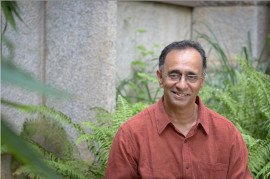Master of Science in Biochemistry
Nayim is a PhD student and DBT-TWAS Fellow working on natural products as source of anticancer agents. He obtained his Master degree in Biochemistry at the University of Dschang (Cameroon). He is exploring the effects of plants extracts and their derived compounds against the metastatic Human cervical cancer cells using in vitro and in vivo models.

Nayim Paul
pauln at ncbs dot res dot in
Cervical Cancer and metastasis
Most often, women become susceptible to developing cancer of the cervix following human papilloma viruses (HPV) infection. At advance stage of a primary cervical tumour, a group of malignant cells can break off and spread through the blood stream or lymph vessels to lungs, liver, lymph nodes, brain and bones: a process known as metastasis, the primary cause of death in patients suffering from cancer. Partially reactivated in many types of malignancies by transcription factors, epithelial mesenchymal transition allows a revival of the migratory properties of cancer cells. Numerous cellular signalling pathways are associated with the epithelio-mesenchymal transition including the Transforming Growth Factor beta pathway (TGF-β), the Epidermal Growth Factor (EGF) pathway, the Fibroblast Growth Factor (FGF) pathway, the Wnt/β-catenin pathway, the Notch pathway and phosphatidylinositol 3-kinase/AKT/Snail signalling.
Cervical cancer’s treatment and Natural products
Cervical cancer patients are treated with combination of radiation and chemotherapy; unfortunately, one of the most critical problems associated with cancer treatment is the resistance developed by cervical tumors against these therapies. Sweta et al. (2019) studied the molecular pathways in the cervical tumours and found that some cells of the tumour, which are resistant to radiotherapy, have increased expression of a particular protein (RhoC) leading to enhanced DNA repair in cells exposed to radiation. Therefore, searching and developing new drugs able to effectively cure the primary cancer as well as metastasis will be of great benefit for cancer patients. Our focus is exploring medicinal plants as source of anticancer drugs with lower toxicity. Plant kingdom is made up of around 250, 000 species (Narayani et al., 2017), which are regularly exposed to stressful conditions due to abiotic and abiotic factors in their living environment. To survive under such difficult and stressful conditions, plants undergo some important modifications like changing in signalling components gene transcription, non-coding RNAs, proteins, leading to synthesis upregulation of some important classes of chemicals known as secondary metabolites, which pharmacological activity is the scientific basis for the use of medicinal plants as drugs.
PUBLICATIONS
Paul Nayim, Armelle Mbaveng, Brice Wamba, Aimé G. Fankam, Joachim K. Dzotam and Victor Kuete. “Anti-bacterial and antibiotic-potentiating activities of thirteen Cameroonian edible plants against Gram negative resistant phenotypes”, Scientific World Journal DOI: 10.1155/2018/4020294
Brice E. N. Wamba#, Paul Nayim# , Armelle T. Mbaveng , Igor K. Voukeng, Joachim K. Dzotam, Ornella J. T. Ngalani, and Victor Kuete. Syzygium jambos Displayed Antibacterial and Antibiotic-Modulating Activities against Resistant Phenotypes, Evidence-Based Complementary and Alternative Medicine: Volume 2018, Article ID 5124735, 12 pages; https://doi.org/10.1155/2018/5124735,
Brice E. N. Wamba, Armelle T. Mbaveng , Paul Nayim, Joachim K. Dzotam, Ornella J. T. Ngalani, and Victor Kuete. Antistaphylococcal and Antibiotic Resistance Modulatory Activities of Thirteen Cameroonian Edible Plants against Resistant Phenotypes, International Journal of Microbiology Volume 2018, Article ID 1920198, 12 pages; https://doi.org/10.1155/2018/1920198



